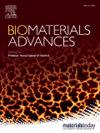抗mir21结合DNA纳米水凝胶增强癌症治疗。
IF 6
2区 医学
Q2 MATERIALS SCIENCE, BIOMATERIALS
Materials Science & Engineering C-Materials for Biological Applications
Pub Date : 2024-12-24
DOI:10.1016/j.bioadv.2024.214160
引用次数: 0
摘要
MicroRNAs (miRNAs)是非编码的内源性小单链RNA分子,参与基因表达的转录后调控。研究表明,miRNA的失调在肿瘤的形成、增殖和转移中起着重要作用。因此,递送抗mirna寡核苷酸来阻断这些致癌mirna的活性是一种高潜力的抗癌治疗方法。特别是,miRNA-21 (miR-21)可以成为一个很好的靶点,因为它是一种致癌miRNA,在胶质母细胞瘤、乳腺癌和结肠癌等多种癌症中上调。然而,抗mirna在生理环境中不稳定,细胞膜通透性低,难以在癌细胞内积累到一定浓度,从而产生抗癌作用。为了克服这些困难,我们开发了抗mir -21功能化的DNA水凝胶(amiR-21 Dgel)。我们在体外证实了miR-21凝胶提高了生理稳定性,并观察到它在HeLa细胞中阻断了96.6%的miR-21,并在72小时内将细胞存活率降低到77.9%。特别是,RT-qPCR分析表明,阻断miR-21诱导肿瘤抑制基因PTEN和PDCD4的mRNA表达分别增加了6.23倍和6.87倍。此外,凝胶可以作为药物递送载体,嵌入抗癌药物,如阿霉素(Dox),将其递送到细胞中。DOX是一种抗癌药物,与amiR-21一起给药,显示出协同抗癌作用。我们期望这种方法将为利用反义mirna进行抗癌治疗提供一种方便的优化和高效的策略。本文章由计算机程序翻译,如有差异,请以英文原文为准。

Anti-miR21-conjugated DNA nanohydrogel for enhanced cancer therapy
MicroRNAs (miRNAs) are non-coding, endogenous small single-stranded RNA molecules involved in post-transcriptional regulation of gene expression. It has been demonstrated that dysregulation of miRNA plays a major role in tumor formation, proliferation, and metastasis. Therefore, the delivery of anti-miRNA oligonucleotides to block the activity of these oncogenic miRNAs is a high-potential anti-cancer therapy approach. In particular, miRNA-21 (miR-21) can be an excellent target as it is an oncogenic miRNA that is upregulated in various cancers including glioblastoma, breast cancer, and colon cancer. However, anti-miRNAs are unstable in the physiological environment and have low cell membrane permeability, making it difficult to accumulate at certain concentrations to have anti-cancer effects within cancer cells. To overcome these difficulties, we developed anti-miR-21 functionalized DNA hydrogel (amiR-21 Dgel). We confirmed the improved physiological stability of amiR-21 Dgel in vitro, and observed that it blocked up to 96.6 % of miR-21 in HeLa cells, and reduced cell viability down to 77.9 % for 72 h. In particular, RT-qPCR analysis demonstrated that blocking of miR-21 induces increased mRNA expression of the tumor suppressor genes, PTEN and PDCD4 by 6.23- and 6.87-fold, respectively. In addition, the Dgel can act as a drug delivery vehicle, intercalating anticancer drugs such as doxorubicin (Dox) to be delivered into cells. DOX, an anticancer drug, showed a synergistic anticancer effect with amiR-21, which was delivered together. We expect that this approach will be a convenient to optimization and highly effective strategy for anticancer therapy employing antisense miRNAs.
求助全文
通过发布文献求助,成功后即可免费获取论文全文。
去求助
来源期刊
CiteScore
17.80
自引率
0.00%
发文量
501
审稿时长
27 days
期刊介绍:
Biomaterials Advances, previously known as Materials Science and Engineering: C-Materials for Biological Applications (P-ISSN: 0928-4931, E-ISSN: 1873-0191). Includes topics at the interface of the biomedical sciences and materials engineering. These topics include:
• Bioinspired and biomimetic materials for medical applications
• Materials of biological origin for medical applications
• Materials for "active" medical applications
• Self-assembling and self-healing materials for medical applications
• "Smart" (i.e., stimulus-response) materials for medical applications
• Ceramic, metallic, polymeric, and composite materials for medical applications
• Materials for in vivo sensing
• Materials for in vivo imaging
• Materials for delivery of pharmacologic agents and vaccines
• Novel approaches for characterizing and modeling materials for medical applications
Manuscripts on biological topics without a materials science component, or manuscripts on materials science without biological applications, will not be considered for publication in Materials Science and Engineering C. New submissions are first assessed for language, scope and originality (plagiarism check) and can be desk rejected before review if they need English language improvements, are out of scope or present excessive duplication with published sources.
Biomaterials Advances sits within Elsevier''s biomaterials science portfolio alongside Biomaterials, Materials Today Bio and Biomaterials and Biosystems. As part of the broader Materials Today family, Biomaterials Advances offers authors rigorous peer review, rapid decisions, and high visibility. We look forward to receiving your submissions!

 求助内容:
求助内容: 应助结果提醒方式:
应助结果提醒方式:


